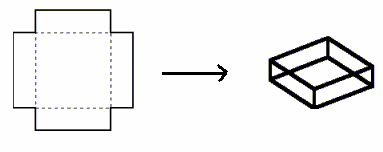Part of a DEMO
Word Problem: Maximum Volume of a Box
Cutting Squares for Maximum Volume

To find the maximum volume of a box made by cutting squares from each corner of a rectangular piece of cardboard of size L by W and folding up the sides, you can use calculus. Let x be the side length of the squares cut from each corner. The volume V of the box can be expressed as a function of x: \[V(x)=(L-2x)(W-2x)x\] To find the maximum volume, you need to take the derivative of V(x) with respect to x, set it to zero, and solve for x. This will give you the critical points where the volume might be maximized. For example, if the cardboard dimensions are 15 inches by 24 inches, the volume function becomes: \[V(x)=(15-2x)(24-2x)x\] The value of x will have a range from more than 0 to less than 7.5 inches, because you can't cut two squares of 7.5 inches from the corners of a piece of cardboard which is 15 inches long because the result is there will be no bottom.
After finding the critical points, you can use the second derivative test to confirm that the critical point corresponds to a maximum volume. Alternatively, you can evaluate the volume function at the critical points and at the boundaries of the domain to determine the maximum volume. For a more practical approach, you can use graphing calculators or software to visualize the volume function and find the maximum volume.
The procedure is outlined above and below are a set of steps to determine the maximum volume for the example.
Maximize \(V(x) = (15-2x)(24-2x)x\). We first expand terms of the product in V(x); the result is \(4x^3 - 78x^2 + 360x\).
To find the maximum value, we take the derivative of the V(x) and set it to zero: let \(V^{'}(x)\) represent the derivative of V(x)\).
\[ V^{'}(x) = 12x^2 - 156x + 360\]
Setting the derivative equal to zero so we can determine the critical points: \[V^{'}(x) = 12x^{2} - 156x + 360 = x^{2} - 13x + 30 = 0\] by solving this quadratic equation we get \(x = 3\) and \(x = 10\). Since the value of \(x\) has a range from 0 to 7.5 we can't use \(x = 10\) so the only critical point is \(x = 3\).
To verify that the critical point \(x = 3\) can be used to compute \(V(3)\) is the maximum volume we can use the second derivative to check this.
The second derivative is denoted by \(V^{''}(x)\). This check is as follows:
if \(V^{''}(3) \lt 0\) then at \(x = 3\) is a local minimum or \(V^{''}(3) \gt 0\) then at \(x = 3\) is a local maximum.
In this example
\(V^{''}(x) = 2x -13\) and \(V^{''}(3) = -7\) so we have a local maximum. Hence the maximum volume is \(V(3) = 4(3^3) - 78(3)^2 + 360(3) = 486\).
==================================================================
David R. Hill: click below to see more in mathdemos.org.